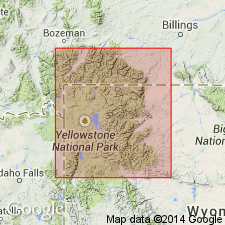
- Usage in publication:
-
- Elk Creek basalt
- Modifications:
-
- Original reference
- Dominant lithology:
-
- Basalt
- AAPG geologic province:
-
- Yellowstone province
Summary:
Pg. 33-36, 78 (table 9), pl. 4. Elk Creek basalt. Highly porphyritic basalt; the phenocrysts of feldspar are tabular, and average about one-quarter inch in size. Normally blue black. Intensely altered locally. Color of altered phases is lighter and in some places is almost white. Younger than Crescent Hill basalt (new) and older than Lost Creek trachyte (new). Age is Miocene and (or) Pliocene.
Well exposed at southeast base of Crescent Hill, near mouth of Elk Creek where it forms a bench, Yellowstone National Park, northwestern WY.
Source: US geologic names lexicon (USGS Bull. 1200, p. 1231).

- Usage in publication:
-
- Elk Creek Basalt Member*
- Modifications:
-
- Revised
- Dominant lithology:
-
- Lava
- Shoshonite
- AAPG geologic province:
-
- Yellowstone province
Summary:
Pg. C10-C11 (fig. 8), C16-C17. Elk Creek Basalt Member of Sepulcher Formation of Washburn Group of Absaroka Volcanic Supergroup (notably in Sepulcher Mountain and Crescent Hill areas); Elk Creek Basalt Member of Lamar River Formation of Washburn Group of Absaroka Volcanic Supergroup (notably in Specimen Ridge area). Elk Creek Basalt of Howard (1937) interfingers with lower part of the Sepulcher and with the Lamar River, hence the Elk Creek is [revised to] a member of both formations. Consists of 4 or more dark-reddish-brown to black lava flows and flow breccias of potassic basalt or shoshonite containing abundant large phenocrysts of plagioclase and augite; sedimentary interbeds are excluded. Maximum aggregate thickness about 300 feet; in Sepulcher Mountain area thickness ranges from a few feet to about 60 feet. Underlies Lost Creek Tuff Member of Sepulcher Formation, which is dated as 49.2 +/-1.5 Ma. Age is considered late early Eocene (Wasatchian NALMA).
Source: Publication.
For more information, please contact Nancy Stamm, Geologic Names Committee Secretary.
Asterisk (*) indicates published by U.S. Geological Survey authors.
"No current usage" (†) implies that a name has been abandoned or has fallen into disuse. Former usage and, if known, replacement name given in parentheses ( ).
Slash (/) indicates name conflicts with nomenclatural guidelines (CSN, 1933; ACSN, 1961, 1970; NACSN, 1983, 2005, 2021). May be explained within brackets ([ ]).

